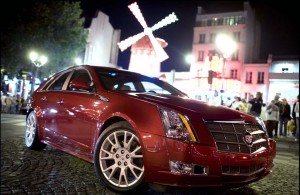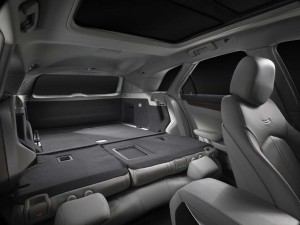A fuel prices rise, there’s been a slow but steady shift in demand in the U.S. market, buyers downsizing both the cars they drive and the engines that power them. In fact, the American market is beginning to look more and more like Europe’s, where compact models serve the same purpose as mid-size models do here.
But one gap remains. Europeans love station wagons, the body style that Baby Boomers abandoned as they entered their rebellious youth. Too bad. Wagons are a functional and fuel-efficient alternative to the crossovers and sport-utility vehicles that dominate American roads.
But the 2010 Cadillac CTS Sport Wagon could help shift that mindset. Based off the same platform as Caddy’s CTS sedan, it’s stylish as well as utilitarian. And it’s drawing a small but loyal following that could give momentum to those reluctant industry planners considering other wagon programs.
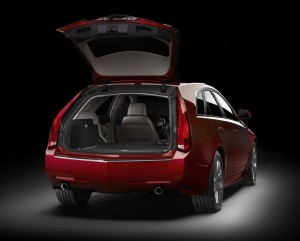
Open wide! The 2010 Cadillac CTS Sport Wagon has nearly the cargo space of the second-generation Caddy SRX crossover.
The debut of Cadillac’s first wagon coincides with the launch of an all-new SRX. The first-generation crossover was neither fish nor foul, with a shape that didn’t quite win over CUV buyers but wasn’t quite sleek enough to fit into the wagon category.
Now, however, this cleaving gives these distinct buyer groups precisely what they want and need.
At a time when aerodynamics are driving much of the industry’s styling, luxury cars have become increasingly look-alike, but the CTS is a distinct standout, with its edgy lines and vertical head and taillamps. The Sport Wagon shares its basic design cues with the sedan; in Caddy terms, the Art & Science design language. But the sweeping roof line and the narrow vertical taillamps now sweep upwards nearly three feet and bring to mind nothing less than the fins of Cadillacs past.
There are a few trade-offs, notably the loss of some rear visibility due to the wagon’s large rear pillar. But rear parking sensors and a backup camera help overcome that issue.
As with the exterior, the Sport Wagon’s cabin carries over the CTS sedan’s elegant design. Caddy stylists made significant strides with the second-generation’s appearance. To call it elegant may seem clichéd, but the look is decidedly more up-market and refined, with well-matched woods, leather and chrome, while even the obligatory plastic components have been carefully matched to maintain color and grain.
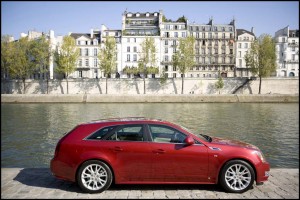
The 2010 Cadillac CTS Sport Wagon in Amsterdam. Europeans look much more favorably at the wagon's traditional 2-box design.
Knobs and buttons are well-positioned and feel good to the touch. Better yet, they’ve been intuitively designed to do what you’re likely to need without having to fall back on a complicated central control device, like the oft-maligned BMW iDrive or Audi MMI. Of course, it helps to have an absolutely huge touch-screen monitor that slides back into the center stack when not in use. If we have any complaints, it’s the voice-control system. Pairing up a Bluetooth-equipped phone can be a chore, requiring not just too many steps but a knowledge of the arcane verbal commands Caddy engineers opted for.
Then again, if you’ve opted for one of the available OnStar packages, you can minimize your learning curve for the navigation system; simply press a button and wait for the operator to come online. They’ll program the destination in for you and immediately upload your route to the car.
The Sport Wagon’s seats are comfortable yet supportive, holding you in place even under aggressive driving maneuvers. But another downside to the sweeping arc of the roofline is that rear headroom is a bit limited.
But there’s still a satisfying amount of cargo space. With rear seats down, you’ll have more than enough room to haul a bicycle – or 58 cubic feet of lumber, groceries or whatever you need to tote. Even with the back seats up, there’s a full 25 cf of cargo room – though the steeply raked roofline means the cargo compartment isn’t quite as easy to access, especially with odd-shaped packages, as the SRX’s.
One particularly nice feature the 2010 Cadillac CTS Sport Wagon shares with the ’10 Caddy SRX is a programmable liftgate. A dial on the driver’s door lets you adjust the height the power hatch will open to, a blessing if you park in a low garage.
Once upon a time, GM planners had considered offering a diesel in the CTS Sport Wagon, a seemingly sound choice considering the possibilities that opened up for the European market. Sadly, the automaker decided to abandon plans for a smaller diesel that could be offered in the U.S., as well. But the two powertrains American motorists now can choose from should satisfy all but the most dedicated fans of modern oil-burner technology.
That includes a base, 3.0-liter V6 churning out 270 horsepower. It’s a solid and reliable powertrain that is fine for those watching their budget, though the bigger 3.6-liter V6 really bumps up the fun factor, with its 304 hp and 273 pound-feet of torque.
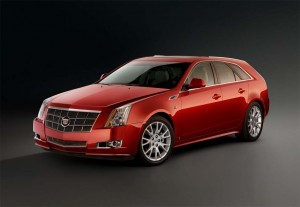
The 2010 Cadillac CTS Sport Wagon follows the same Art & Science design theme as the CTS sedan and other Caddy offerings.
Don’t confuse “Sport” with “muscle,” however. This isn’t a Dodge Magnum with a full-blown Hemi under the hood. The bigger Caddy engine will get you from 0 to 60 in just under 7 seconds in Sport Mode — a good place to keep things set considering the slight delay we otherwise found between the time when we tipped the throttle and the engine got the message to start hauling.
Other than saving a few bucks a month, we’re not really sure why many buyers would opt for the smaller V6. The 3.6 features direct injection, which minimizes the fuel economy penalty. You’ll get an EPA-rated 18 City/27 Highway with the rear-drive 3.0-liter package, or 18/26 for the bigger V6. Both engines can be ordered in all-wheel-drive configuration, and there, surprisingly, the EPA numbers for both models come in at 18/26 mpg.
The second-generation CTS has received strong kudos for its stiff, stable suspension. It’s point-and-shoot driving, yet doesn’t beat you up, even on the rough roads we live with in Michigan. Sedan and wagon have pretty much the same road manners. And, thanks to a significant upgrade in the use of foam insulation and other materials, you don’t get the boominess that many wagons, utes and crossovers suffer from, especially in the rear seat.
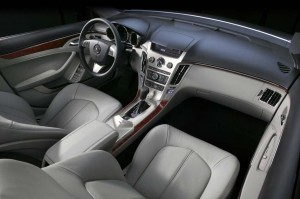
Like the Caddy sedan, the interior of the 2010 Cadillac CTS Sport wagon is one of the most refined the brand has ever marketed.
At a starting price of $40,485, the 2010 Cadillac CTS Sport Wagon is a bargain compared to its Asian and European luxury competitors. Sadly, there aren’t enough left in the wagon segment, though if Caddy succeeds to build demand, we could see some import offerings return. Sure, CUVs and SUVs may be the hip body styles, but the wagon is a stylish, functional and – in the case of the CTS Sport Wagon – affordable alternative that buyers would be foolish not to consider.

